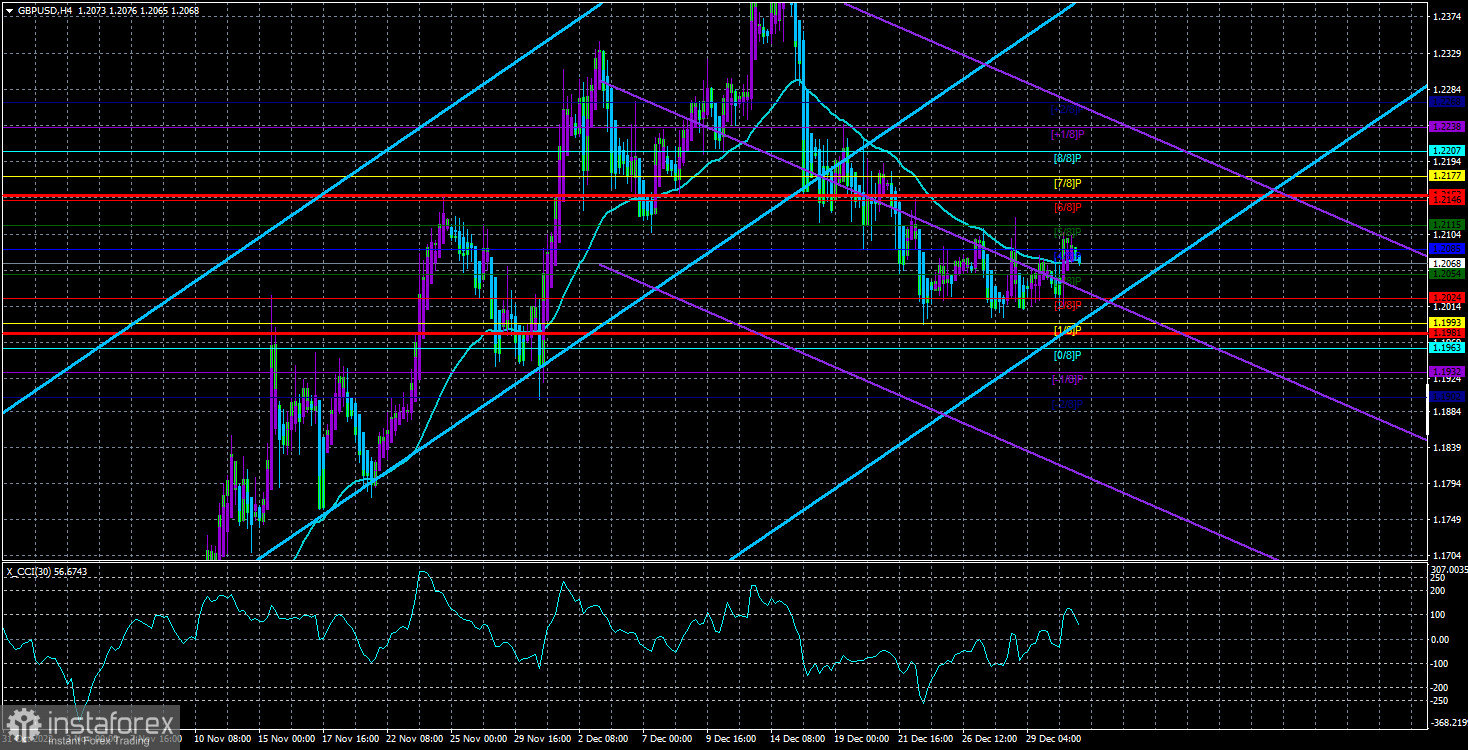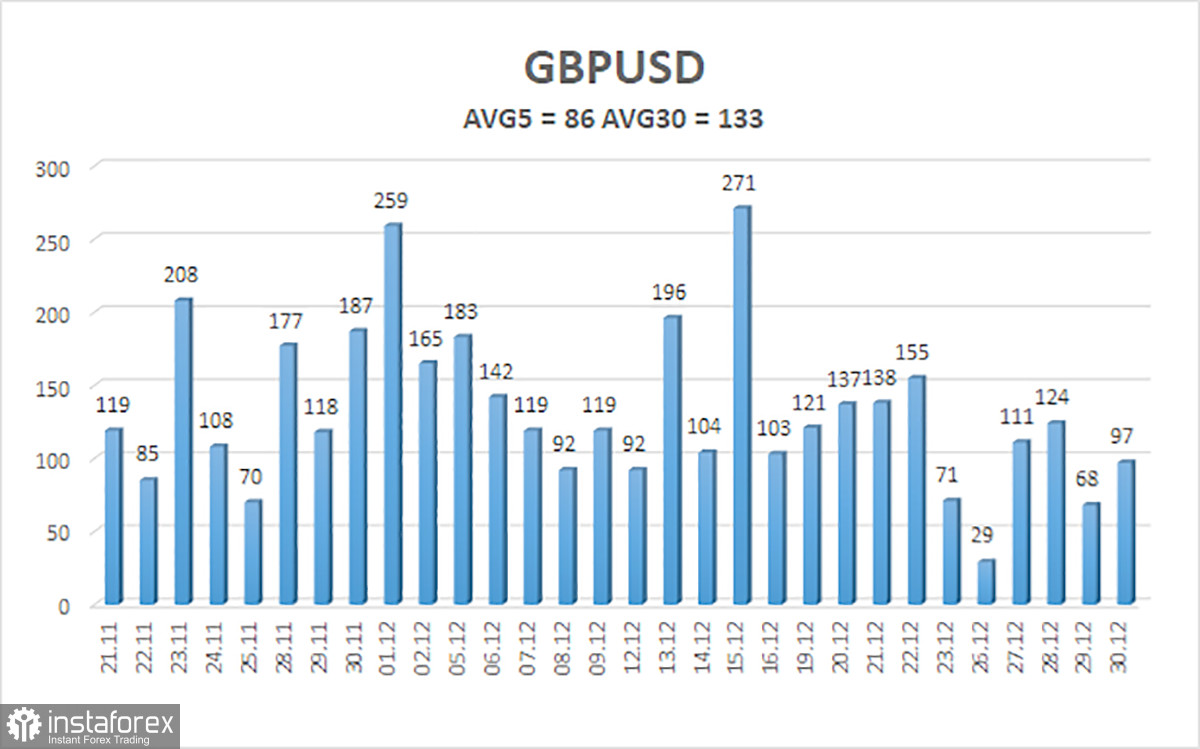
The GBP/USD pair remained in the trading range on Friday. The pound sterling had made a robust correction in the last two weeks in line with our technical expectations. However, in the final days of the year, the currency pair got stuck in a range. The question is what further direction the instrument will take. On the one hand, we reckon that the downward correction could be deeper. On the other hand, the single European currency has been extending its growth, capable of pushing the sterling up. Besides, there are no fundamental and macroeconomic grounds for GBP's growth. So, GBP/USD might be able to rebound through sheer inertia because the protracted downward correction is over. Interestingly, the sterling has already surged by 2,500 pips in the last 2.5 months. All in all, we should consider a plethora of mixed factors. Under such circumstances, we conclude that GBP/USD is entering a long consolidation stage. It means that the instrument is going to move up and down with swings of 400-500 pips.
On Friday, GBP/USD settled above the moving average, but this doesn't mean anything because the currency pair has been firmly stuck on a flat market. The pair has been trading between 1.1993 and 1.2115. Until the price leaves this trading range, we cannot predict any trendy move. Meanwhile, we can trade the currency pair on smaller timeframes within the trading range.
US nonfarm payrolls, which are on tap on Friday, January 6, could bring the flat market to an end.
This week, the economic calendar for the UK is nearly empty. Nevertheless, the manufacturing PMI for December will be available tomorrow, the services PMI is due on Thursday, and the construction PMI will be posted on Friday.
Certainly, these metrics will hardly make an impact on market sentiment because they are of secondary importance. They will be revised readings for December. Therefore, the market will focus on data for the US which will be more important and more numerous.
On Tuesday, market participants will get to know the US manufacturing PMI. The ISM manufacturing PMI will be on tap on Wednesday which is a report of crucial importance. The last report showed that the index dipped below the threshold level which came as no surprise. Indeed, all major economies are dipping into a recession slowly but surely. The recession in the US could be meagre and short-lived. Nevertheless, it doesn't cancel the fact that most of the macroeconomic indicators will enter the negative territory throughout 2023. If we don't see a sharp decline in the ISM PMI, the market will give a muted response. Notably, GBP/USD has been trading sideways. The price will oscillate robustly within the borders but it will hardly exit the established trading range following the ISM report.
On Thursday, the ADP payroll processor will unveil its employment report which commonly doesn't coincide with the official nonfarm payrolls. In fact, the ADP report could be dismal but the nonfarm payrolls could show buoyant hiring. Therefore, I would recommend we judge the US labor market by the government data, not by the ADP report. Another report which is due on Thursday is the US services PMI for December.
The highlight of the week will be certainly Friday: the day when the market will absorb the employment data in the US public and private sectors, wages, and the ISM non-manufacturing PMI for December. Each of these reports could serve as a market catalyst. On top of that, all of them could set the market in motion. Of course, market participants will mainly focus on the nonfarm payrolls and the ISM PMI. The nonfarm payrolls always make a strong impact on market sentiment. As for the ISM PMI, it will depend on how much it will deviate from the forecast and the previous score. To sum up, the odds are that GBP/USD will eventually leave the trading range on Friday. Until then, the currency pair is going to stay in the range-bound market for almost a week.

GBP/USD's average volatility has been about 86 pips in the last 5 trading days. Such volatility is mediocre for GBP/USD. On Monday, January 2, we expect the instrument to trade within the trading range between 1.1981 and 1.2153. A downward reversal of Heikin Ashi will signal a probable downward move within the trading range.
Nearest support levels:
S1 – 1.2054
S2 – 1.2024
S3 – 1.1993
Nearest resistance levels:
R1 – 1.2085
R2 – 1.2115
R3 – 1.2146
Trading tips
GBP/USD has been locked inside the trading range on the 4-hour chart. Thus, the reasonable strategy is trading at a bounce from 1.1993 (1.2024) and at a drop from 1.2115. Besides, we could plan positions on smaller timeframes.
Comments on charts:
Linear regression channels help to determine the ongoing trend. If both channels point at the same direction, a strong trend is unfolding now.
Moving average line (settings 20.0, smoothed) determines the short-term trend and the direction in which you should now trade.
Murray levels are target levels for movements and corrections.
Volatility levels (red lines) are a likely price channel in which the pair will trade in the nearest 24 hours, based on current volatility indicators.
The CCI indicator. Its entry into the oversold area (below -250) or overbought area (above +250) means that the price is about to reverse in the opposite direction.
 English
English 
 Русский
Русский Bahasa Indonesia
Bahasa Indonesia Bahasa Malay
Bahasa Malay ไทย
ไทย Español
Español Deutsch
Deutsch Български
Български Français
Français Tiếng Việt
Tiếng Việt 中文
中文 বাংলা
বাংলা हिन्दी
हिन्दी Čeština
Čeština Українська
Українська Română
Română

